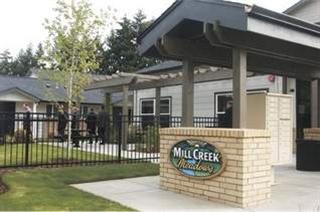
SALEM, OR - Dottie Raines was excited about the new hardwood floors included in the renovation of her affordable housing complex, Mill Creek Meadows, and so were her two cats, Bear and Pumpkin. "They can slip and slide across the floor when they're playing," Raines said. "When I first moved in, they had a blast." She has lived at the 19-unit complex since March 2006 and cannot believe the changes Salem-Keizer Community Development Corporation has made. On the wall facing the street, the window was so high up, she could hardly see out of it. "I was shocked when I seen the big bay window come up," she said.
CDC, a nonprofit group that builds affordable housing, put on a party Sept. 24. The group celebrated not only the completion of its new project, Mill Creek Meadows in northeast Salem, but also the project's addition to the area's limited affordable housing stock. The $5 million rehabilitation of a 19-unit facility built in the 1950s was finished in July.
During the improvement process, 12 units for the developmentally disabled were added to the complex at 200 25th St. NE. The developmentally disabled housing is an entirely new, standalone building that includes a computer lab and common area. Qualifying residents make between $11,950 to $28,400 per year to live in the complex, all 31 units are rented.
Improvements to the old complex included ripping out the old wood wall paneling and replacing it with a coat of cream paint on plain walls. Carpeting also was torn out and replaced with wooden floors. Four apartments also were topped with a second story, transforming them into small town houses. Fresh landscaping also spruces up the site. There also are changes that cannot be seen. "They added more insulation, so it's warm," Raines said, smiling.
Ten of the original 19 tenants remained after the complex converted to affordable housing, said Bruce Crane, the executive director of Salem-Keizer CDC. Those who did not meet the income qualifications were relocated with assistance from CDC. Mill Creek Meadows resident Diane Salazar was living with her daughter and granddaughter in Aumsville and now has her own place in the new building, and a sense of independence. "I'm so happy," Salazar said. "I love it."
Salem City Councilor Brad Nanke said he thinks residents of the area surrounding the renovated complex will feel inspired to improve their own homes. "It's amazing what peer pressure does for the community," Nanke said. Oregon Housing and Community Services director Victor Merced said meeting the need for affordable housing is challenging in a time when construction and other costs are rising. "The word frustrating comes to mind," Merced said. "That's the beauty of it. Hopefully, when the market is in a better position, we'll be able to get more done. So, we'll look forward to that."
Oregon Housing and Community Services, city of Salem, National Equity Fund, West Coast Bank, Network for Oregon Affordable Housing and The Collins Foundation contributed to the Mill Creek Meadows project as did dozens of other groups. Also, at the meeting, there was talk of CDC's new affordable housing project in the works, a 30- to 40-unit, four-story structure on the former McMahan's Furniture & Appliance property at 260 State St., said Rick Stucky, the board development and policy services specialist at Oregon School Boards Association. The furniture store burned down in August 2006.
The bottom floor will be commercial and the top three floors will be residential, Stucky said, adding the target market is those who make 30 percent to 60 percent of the median family income. The median family income for Marion and Polk counties is $56,200. Construction is scheduled to start next year, and the project is scheduled to be completed by the end of 2010 or early 2011, Stucky said.
Increasing the availability of affordable housing, and revitalizing downtown is the goal, he said. "By providing housing for those who can't afford market rate housing, it helps the downtown because it gets more people living downtown and it gets that 24 hour downtown atmosphere," Stucky said.
Source: StatesmanJournal.com